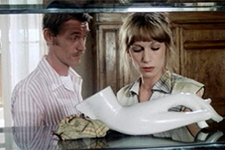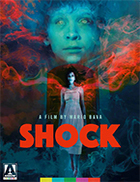Shock
|  Shock was the final film helmed by Mario Bava, the cinematographer-turned-director who was largely responsible for pioneering Italian horror in the early 1960s, beginning with his expressive Gothic masterpiece Black Sunday (La maschera del demonio, 1960). A technical virtuoso who mixed the art of expressive lighting and camera movement with a grand, Baroque sensibility and a willingness to dive into the kind of dark and gory depths that other filmmakers avoided, Bava carved a unique place for himself in Italian film history. Unfortunately, by the early 1970s his prospects were waning, as several of his films had fared poorly at the box office. His brutal crime thriller Rabid Dogs (Cani arrabbiati, 1974) was shelved before it could be finished, and his most recent directorial job had been the unenviable task of shooting new footage to tack onto his arty box-office disappointment Lisa and the Devil (Lisa e il diavolo, 1974) to turn it into an Exorcist clone titled The House of Exorcism (1975). His son, Lamberto Bava, who had worked with him as an assistant director since Kill, Baby... Kill! (Operazione paura, 1966) and had directorial aspirations of his own, encouraged him to make Shock, which originated with a script by Gianfranco Barberi and Dardano Sacchetti, who had previously worked with Bava on A Bay of Blood (Ecologia del delitto, 1971) (Sacchetti, who was already well on his way to becoming one of the most prolific of Italian B-movie screenwriters, got his start co-writing Dario Argento’s The Cat o’ Nine Tails and would go on to pen a number of Lucio Fulci’s goriest films). The subject matter of Shock, which is essentially a modern updating of the traditional Gothic potboiler, fit neatly into Bava’s extensive body of work, which repeatedly played with the gray area between reality and illusion. The story takes place almost entirely in and around a large villa in Rome that has sat empty for an unknown period of time (enough time for a lot of cobwebs and dust to accumulate) before a young family moves in: the father, Bruno (John Steiner), an airline pilot; the mother, Dora (Daria Nicolodi); and their precocious 7-year-old son, Marco (David Colin Jr.). The film slowly reveals that the house and the family have a history: Dora used to live there with Carlo, her drug-addicted first husband and Marco’s biological father, who died by suicide some time previously. The trauma of that marriage and her husband’s death caused Dora to have a nervous breakdown, at which point she was hospitalized. But, as the eternally optimistic (or thick-headed) Bruno continually assures her, she is alright now. Except that, of course, Dora is not alright—no one and nothing is alright—as she comes to believe that the house is haunted by Carlo’s ghost, who is tormenting her from the beyond. It appears that Carlo is using Marco for his nefarious purposes, as Marco’s behavior becomes increasingly bizarre and unruly, not to mention overtly sexual in his dealings with Dora (he sneaks into her room and watches her showering and then steals a pair of her underwear from the bureau). The nature of the haunting and Marco’s being possessed by the spirit of his dead father are left purposefully vague for much of the film; Bava loved nothing more than ambiguity, and he deploys it here with an effective sense of menace, ensuring that any interpretation we might proffer is equally disturbing (is Marco a perverted kid with an oedipal fixation, or is he possessed?). But, answers aren’t what the film is really about. Like Bava’s previous works, Shock is about mood and atmosphere and that thin, thin line between the real world and a world of illusions, dreams, and nightmares. Much of the film’s weight lies on the shoulders of Daria Nicolodi, who had appeared in a number of Dario Argento’s films (she also cowrote 1977’s Suspiria). Nicolodi plays the role of the tormented Gothic female protagonist, trapped in a house that is haunted with the sins of the past and preyed upon by a sexualized male predator (in this case, her dead husband through the body of her prepubescent son). Her fragile mental state is key to the film’s ambiguity, and Nicolodi does a fine job of creating a believable protagonist struggling to hold it together in increasingly stressed circumstances. She does a lot of screaming, moaning in her sleep while having nightmares, and crying out in exasperation to Bruno, who simply will not entertain her pleas that they move somewhere else (Steiner, a British actor, is arguably miscast because he had played dozens of villains in Italian genre films during this period and therefore never feels like a decent guy trying to do the right thing). As the title implies, there are some good moments of genuine surprise scattered throughout Shock, although sometimes it feels like it is moving too slowly for its own good. There are a few gory setpieces and some fantastically surreal dream sequences, including one where a brick wall begins to bleed and another where Carlo’s ghost, in the form of light shaped like hands, moves his way up Dora’s sleeping body and begins pulling the sheet off her. Bava plays throughout with light and shadow, toying with our desire to see things in pools of light and murky darkness (at one point he gives us a ghostly light moving around the basement only to reveal that it is Marco shining a lantern through a family photograph in which he has cut out his stepfather). We get lots of handheld cameras prowling through the house, but also some genuinely effective means of visual dramatization, such as the moment when the camera slowly pulls away from Dora and Bruno fighting until it has completely left the room. Of course, all the film’s artistry is ultimately in the service of a relatively slight narrative that melds together the Gothic tradition with elements of modern horror that were popular at the time. When Shock was released in the U.S., it was retitled Beyond the Door II in an attempt to link it to the Exorcist knock-off Beyond the Door (Chi sei?, 1974), which also featured David Colin Jr. in his only other screen role. The fact that there is no demonic possession in the film and it is otherwise entirely unrelated to Beyond the Door made no difference, just as it made no difference to Italian distributors who created the illusion that Lucio Fulci’s Zombie (1979) was a sequel to George A. Romero’s Dawn of the Dead (1978) by slapping a 2 after Zombi, the title under which Dawn was released in Italy. Such practices were par for the course when it came to the distribution of European genre films, and while they may have made Shock seem like another piece of disposable schlock, it is has persisted as one of Bava’s more intriguing late films and evidence that, despite the downward trajectory of his career at that point, he still had plenty to offer.
Copyright © 2021 James Kendrick Thoughts? E-mail James Kendrick All images copyright © Arrow Video | |||||||||||||||||||||||||||||
Overall Rating: 

 (3)
(3)


